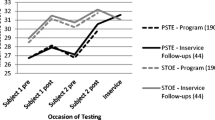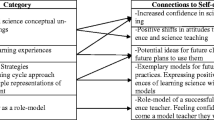Abstract
Research studies have reported an overall positive change of attitude toward teaching science after prospective elementary teachers complete a science methods course. The studies also reveal an absence of a description of the attitude change from the individual participant's point of view. It was the purpose of this three-year qualitative study to generate a framework of categories to describe perspective teachers' change of attitude toward teaching science over the term of a science methods course. Participants were graduate change-of-career prospective elementary science teachers. Sources of narrative data were participants' science journal entries and post-lesson plan comments.
Similar content being viewed by others
References
Adams, P. E., & Tillotson, J. W. (1995). Why research in the service of science teacher education is needed.Journal of Research in Science Teaching, 32, 441–443.
Bennett, C. (1991). The teacher as decision maker program: An alternative for career-change preservice teachers.Journal of Teacher Education, 42, 119–130.
Clandinin, D. J. (1986).Classroom practice: Teacher images in action. Philadelphia: Falmer.
Cox, C. A., & Carpenter, J. R. (1989). Improving attitudes toward teaching science and reducing science anxiety through increasing confidence in science ability in inservice elementary school teachers.Journal of Elementary Science Education, 1(2), 14–34.
Earl, R. D., & Winkeljohn, D. R. (1977). Attitudes of elementary teachers toward science and science teaching.Science Education, 61, 41–45.
Edelfelt, R. A. (1994). Final thoughts on alternative certification.Educational Forum, 58, 220–223.
Eisner, E. W. (1991).The enlightened eye: Qualitative inquiry and the enhancement of educational practice. New York: Macmillan.
Feistritzer, C. M. (1994). The evaluation of alternative teacher certification.Educational Forum, 58, 132–138.
Flick, L. (1990).Affecting preservice elementary teachers' attitudes toward inquiry teaching in science through projects with individual children. Paper presented at the annual meeting of the National Association for Research in Science Teaching, Atlanta, GA. (ERIC Document Reproduction Service No. ED 319 596)
Gega, P. (1994).Science in elementary education (7th ed.). New York: Macmillan.
Ginns, I. S., & Foster, W. J. (1983). Preservice elementary teacher attitudes toward science and science teaching.Science Education, 67, 277–282.
Glaser, B. C., & Strauss, A. L. (1967).The discovery of grounded theory: Strategies for qualitative research. Chicago: Aldine.
Harty, H., Samuel, J. V., & Andersen, H. O. (1991). Understanding the nature of science and attitudes toward science and science teaching of preservice elementary teachers in three preparation sequences.Journal of Elementary Science Education, 3(1), 13–22.
Kagan, D. M. (1992). Professional growth among preservice and beginning teachers.Review of Educational Research, 62, 129–169.
Kennedy, T. G. (1973). The effect of process approach instruction upon changing pre-service elementary teachers' attitudes toward science.School Science and Mathematics, 73, 569–574.
Lawrenz, R., & Cohen, H. (1985). The effect of methods classes and practice teaching on student attitudes toward science and knowledge of science processes.Science Education, 69, 105–113.
McDevitt, T. M., Heikkinen, H. W., Alcorn, J. K., Ambrosio, A. L., & Gardner, A. L. (1993). Evaluation of the preparation of teachers in science and mathematics: Assessment of preservice teachers' attitudes and beliefs.Science Education, 77, 593–610.
Merriam, S. B. (1988).Case study research in education: A qualitative approach. San Francisco: Jossey-Bass.
Mitchell, J. C. (1984). Typicality and the case study. In R. F. Ellen (Ed.),Ethnographic research (pp. 238–240). New York: Academic Press.
Morrisey, J. T. (1981). An analysis of studies on changing the attitude of elementary student teachers toward science and science teaching.Science Education, 65, 157–177.
Mulholland, J., & Wallace, J. (1996). Breaking the cycle: Preparing elementary teachers to teach science.Journal of Elementary Science Education, 8(1), 17–38.
Myers, D. G. (1980, November 21). Faith and action: A seamless tapestry.Christianity Today, 24(10–19), 1406–1409.
Myers, D. G. (1987).Social psychology (2nd ed.). New York: McGraw-Hill.
National Research Council. (1994).National science education standards draft only. Washington, DC: National Academy Press.
Oliver, J. S. (1989). An update on attitude research and the teaching of science.Journal of Elementary Science Education, 1(1), 3–5.
Pedersen, J. E., & McCurdy, D. W. (1992). The effects of hands-on, minds-on teaching experiences on attitudes of preservice elementary teachers.Science Education, 76, 141–146.
Scott, M. M. (1991). Naturalistic research: Applications for research and professional practice with college students.Journal of College Student Development, 32, 416–423.
Shannon, I. L. (1990). ASEP—An alternative certification program for career switchers that work.Action in Teacher Education, 14(4), 38–42.
Shrigley, R. L. (1974). The attitudes of pre-service elementary teachers toward science.School Science and Mathematics, 74, 243–251.
Sivertsen, M. L. (1993).Transforming ideas for teaching and learning science: A guide for elementary science education. Washington, DC: Office of Research, U.S. Department of Education.
Sparks-Langer, G. M., & Colton, A. B. (1991). Synthesis of research on teachers' reflective thinking.Educational Leadership, 48(6), 37–44.
Stefanich, G. P., & Kelsey, K. W. (1989). Improving science attitudes of preservice elementary teachers.Science Education, 73, 187–194.
Surbeck, E., Han, E. P., & Moyer, J. E. (1991). Assessing reflective responses in journals.Educational Leadership, 48(6), 25–27.
U.S. Department of Education. (1991).Certification for teachers: A new career for you. Washington, DC: Author.
Wenner, G. (1993). Relationship between science knowledge levels and beliefs toward science instruction held by preservice elementary teachers.Journal of Science Education and Technology, 2, 461–468.
Zumalt, K. (1991). Alternative route to teaching: Three alternative approaches.Journal of Teacher Education, 42(2), 83–92.
Author information
Authors and Affiliations
Additional information
AETS-Sponsored Column on Elementary Science Teacher Education
Rights and permissions
About this article
Cite this article
Bohning, G., Hale, L. Images of self-confidence and the change-of-career prospective elementary science teacher. J Elem Sci Edu 10, 39–59 (1998). https://doi.org/10.1007/BF03173586
Issue Date:
DOI: https://doi.org/10.1007/BF03173586




